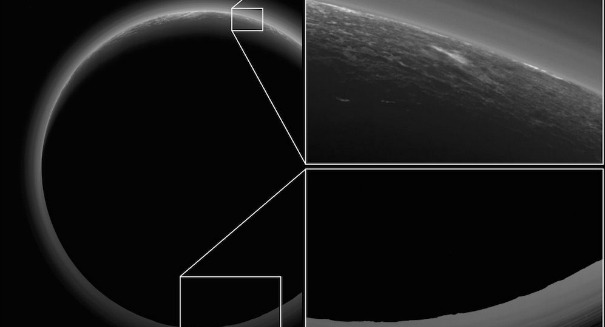
Amazing new "twilight zone" photos of Pluto's surface show spectacular topography of the dwarf planet.
NASA New Horizon’s spacecraft has just produced one of the most astonishing images yet of Pluto’s surface, depicting the dwarf planet’s so-called “twilight zone.”
Mountains, vast plains of nitrogen ice, and even a methane cloud are all visible in the new image produced by NASA from the spacecraft’s July 14, 2015 flyby, according to a NASA statement.
The image was captured at about 13,400 miles from the surface — about 19 minutes after New Horizons was at its closest point to Pluto at about 7,800 miles from the surface. Data and images have been uploading to NASA at a trickle due to the immense distance between the spacecraft and Earth. New Horizons is on its way to explore an object in the Kuiper Belt.
The image shows a backlit twilight view of the dwarf planet, filtering sunlight through the layers of Pluto’s atmosphere and making it possible to see a mountain range and the dwarf planet’s plains.
It also appears to capture a low-lying cloud in the atmosphere, the first to be identified via New Horizons’ photographs. The night side of Pluto appears to have a rugged terrain of valleys and peaks.
“The inset at top right shows a detail of Pluto’s crescent, including an intriguing bright wisp (near the center) measuring tens of miles across that may be a discreet, low-lying cloud in Pluto’s atmosphere; if so, it would be the only one yet identified in New Horizons imagery,” the statement reads. “This cloud – if that’s what it is – is visible for the same reason the haze layers are so bright: illumination from the sunlight grazing Pluto’s surface at a low angle. Atmospheric models suggest that methane clouds can occasionally form in Pluto’s atmosphere. The scene in this inset is 140 miles (230 kilometers) across.
“The inset at bottom right shows more detail on the night side of Pluto,” it continues. “This terrain can be seen because it is illuminated from behind by hazes that silhouette the limb. The topography here appears quite rugged, and broad valleys and sharp peaks with relief totaling 3 miles (5 kilometers) are apparent. This image, made from closer range, is much better than the lower-resolution images of this same terrain taken several days before closest approach. These silhouetted terrains therefore act as a useful ‘anchor point,’ giving New Horizons scientists a rare, detailed glimpse at the lay of the land in this mysterious part of Pluto seen at high resolution only in twilight. The scene in this inset is 460 miles (750 kilometers) wide.”

Leave a Reply